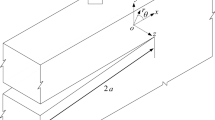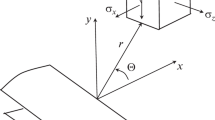Abstract
Several elastic configurations containing cracks under transverse tension which intersect a free surface are investigated. In order to ensure reliable results two independent numerical methods are employed on a comparison problem, each method being tuned to handle the special features involved. The comparison provides confidence in other results which focus on the key quantity in linear elastic fracture mechanics, the energy release rate. These findings may be summarized as follows: that the decays in the energy release rates found as the free surface is approached in the various problems treated are probably not significant from a fracture toughness testing point of view and not of major consequence in cyclic life calculations, although there are some indications that this may not be the case if near-surface residual stress fields are present; and that these variations in energy release rate can be compensated for by relatively minor perturbations in crack-front profiles.
Résumé
On étudie diverses configurations élastiques comportant des fissures coupant une surface libre et soumises à tension transversale. Deux méthodes numériques indépendantes sont utilisées à titre comparatif sur un problème en vue d'obtenir des résultats fiables, chaque méthode étant adaptée en vue de tenir compte des caractéristiques spécifiques au problème.
Cette comparaison donne confiance dans d'autres résultats qui se basent sur un paramètre clé de la mécanique de rupture linéaire et élastique, le taux de relaxation de l'énergie. On peut résumer les conclusions de l'étude comme suit. Le fait que l'on trouve une atténuation du taux de relaxation de l'énergie au für et à mesure qu'on se rapproche d'une surface libre n'a probablement pas, dans les divers problèmes traités, de signification du point de vue de l'essai de ténacité à la rupture, et n'a pas d'influence majeure sur le calcul de la vie en fatigue, bien que certaines indications laissent appréhender que ce n'est pas le cas si sont présents au voisinage de la surface des champs de contrainte résiduelle. En outre, ces variations dans le taux de relaxation de l'énergie peuvent être compensées par des perturbations relativement mineures dans le profil du front de fissure.
Similar content being viewed by others
References
V.V. Panasyuk, A.E. Andrejkiv and M.M. Stadnik,Engineering Fracture Mechanics 13 (1980) 925–937.
V.V. Panasyuk, A.E. Andrejkiv and M.M. Stadnik,Engineering Fracture Mechanics 14 (1981) 245–260.
O.K. Aksentian,Journal of Applied Mathematics and Mechanics (Prikladnaia Mathematika i Mekhanika) 31 (1967) 193–202.
M.L. Williams,Journal of Applied Mechanics 19 (1952) 526–528.
J.P. Benthem,International Journal of Solids and Structures 13 (1977) 479–492.
T. Kawai, Y. Fujitani and K. Kumagai,Proceedings of the International Conference on Fracture Mechanics and Technology (Hong Kong) (1977) 1157–1163.
G.B. Sinclair,Proceedings of the Seventh Canadian Congress of Applied Mechanics (Sherbrooke, Quebec) 1 (1979) 295–296.
R.D. Gregory,Journal of Elasticity 9 (1979) 283–309.
E.S. Folias,Journal of Applied Mechanics 42 (1975) 663–674.
J.P. Benthem and W.T. Koiter (discussion), E.S. Folias (closure),Journal of Applied Mechanics 43 (1976) 374–375.
J.P. Benthem,International Journal of Solids and Structures 16 (1980) 119–130.
Z.P. Bazant and L.F. Estenssoro,International Journal of Solids and Structures 15 (1979) 405–426, 16 (1980) 479–481.
Z.P. Bazant,International Journal of Engineering Science 12 (1974) 221–243.
J.L. Swedlow, “Development of the Program SPECEL, a Special Element for Elasto-Plastic Crack-Tip Stress Analysis”, Report SM 74-10, Department of Mechanical Engineering, Carnegie-Mellon University, Pittsburgh (1974).
J.L. Swedlow,International Journal for Numerical Methods in Engineering 12 (1978) 1779–1798.
Y. Yamamoto and Y. Sumi,International Journal of Fracture 14 (1978) 17–38.
G. Yagawa and T. Nishioka,International Journal for Numerical Methods in Engineering 12 (1978) 1295–1310.
G. Yagawa and T. Nishioka,International Journal of Solids and Structures 16 (1980) 585–595.
I.S. Raju and J.C. Newman,Three-Dimensional Finite-Element Analysis of Finite-Thickness Fracture Specimens, NASA Technical Note D-8414, National Aeronautics and Space Administration, Washington (1977).
M.F.O. de Seabra Pereira, “Three-dimensional Linear-Elastic Fracture Mechanics Analysis of Thick-Walled Pressure Vessel Components, D. Phil. Dissertation, Imperial College of Science and Technology (1977).
A.A. Tseng,Engineering Fracture Mechanics 13 (1980) 939–943.
P.D. Hilton and B.V. Kiefer,Journal of Pressure Vessel Technology 102 (1980) 347–352.
J.P. Gyekenyesi and A. Mendelson,International Journal of Fracture Mechanics 11 (1975) 409–429.
T.A. Cruse and W. Van Buren,International Journal of Fracture Mechanics 7 (1971) 1–15.
C.L. Tan and R.T. Fenner,Proceedings of the Royal Society (London) A369 (1979) 243–260.
E.S. Folias,International Journal of Fracture 16 (1980) 335–348.
B.I. Smetanin and B.V. Sobol,Journal of Applied Mathematics and Mechanics (Prikladnaia Matematika i Mekhanika) 45 (1981) 707–709.
G.B. Sinclair, “Derivation of the Integral Equations for the Three-Dimensional Crack Problem”, Report SM 79-10, Department of Mechanical Engineering, Carnegie-Mellon University, Pittsburgh (1979).
S.P. Timoshenko and J.N. Goodier,Theory of Elasticity (Third Edition) McGraw-Hill, New York (1970).
A.E. Green and W. Zerna,Theoretical Elasticity (Second Edition) Oxford, Clarendon Press (1968).
G.R. Irwin,Journal of Applied Mechanics 24 (1957) 361–364.
J.G. Kaufman, inDevelopments in Fracture Mechanics Test Methods Standardization, ASTM Special Technical Publication 632, Philadelphia (1976) 3–24.
P.D. Bell and W.J. Feeney, “Fractographic Evaluation of Fracture Specimens,” Technical Report AFFDLTR-75-152, Grumman Aerospace Corporation, Bethpage, New York (1976).
J.O. Almen and P.H. Black,Residual Stresses and Fatigue in Metals, McGraw-Hill, New York (1963).
M. Isida,International Journal of Fracture Mechanics 7 (1971) 301–316.
J.L. Sanders,Journal of Applied Mechanics 27 (1960) 352–353.
W.S. Burton, “Some Inherently Three-Dimensional Problems in Linear Elastic Fracture Mechanics”, Ph.D. Dissertation, Carnegie-Mellon University (1984).
A.E.H. Love,Transactions of the Royal Society (London) A228 (1929) 377–420.
D.M. Tracey,Nuclear Engineering and Design 26 (1974) 282–290.
J.S. Solecki, “SHAPES — a Finite Element Program for the Analysis of Elastic Three-Dimensional Cracks,” Report SM 81-12, Department of Mechanical Engineering, Carnegie-Mellon University, Pittsburgh (1981).
M. Stern,International Journal for Numerical Methods in Engineering 14 (1979) 409–421.
J.S. Solecki and J.L. Swedlow,International Journal for Numerical Methods in Engineering, in press.
J.R. Rice,Journal of Applied Mechanics 35 (1968) 379–386.
D.M. Parks,International Journal of Fracture 10 (1974) 487–502.
J. Limtragool, “Investigation of the Three-Dimensional Behavior of a Crack Tip Singularity by Holographic Interferometry”, Ph.D. Dissertation, Carnegie-Mellon University (1982).
J.S. Solecki, “Three-dimensional Finite Element Analysis of Straight and Curved Through Cracks in a Plate”, Ph.D. Dissertation, Carnegie-Mellon University (1984).
E399-81 Standard Test Method for Plane-strain Fracture Toughness of Metallic Materials,1982 Annual Book of ASTM Standards, American Society for Testing and Materials, Philadelphia (1982) 592–622.
Author information
Authors and Affiliations
Rights and permissions
About this article
Cite this article
Burton, W.S., Sinclair, G.B., Solecki, J.S. et al. On the implications for LEFM of the three-dimensional aspects in some crack/surface intersection problems. Int J Fract 25, 3–32 (1984). https://doi.org/10.1007/BF01152747
Received:
Revised:
Issue Date:
DOI: https://doi.org/10.1007/BF01152747




